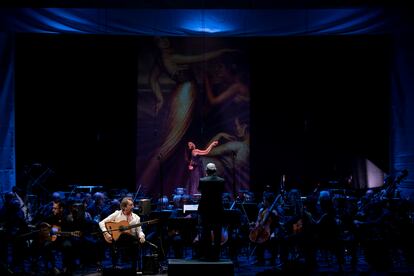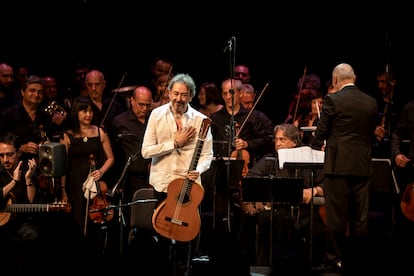Julio Romero de Torres (Córdoba, 1874-1930) was a painter in love with flamenco art, a fact that can easily be verified with a simple review of his extensive work. Through it, one can trace the trace of his deep fondness for flamenco. jondowhich even led him to try his hand at being a singer when he was young. This love is expressed in some of his most famous works, such as Deep Singing, The consecration of the copla or Alegrías. He often included artists of his time in them: the dancer and actress Lolita Astolfi presides over the first and the great Pastora Imperio, the second, in one of the various representations she had in the painting of the Cordovan. He also portrayed, among other figures of the time, La Niña de los Peines and a very young Encarnación López, La Argentinita.
In addition to the human figure, especially the female one, so important in Romero de Torres’ symbolism and allegories, there is another prominent presence, that of the guitar, which in his paintings symbolises flamenco. The six strings were also part of his life, as demonstrated by the image of the sonanta he owned, the protagonist of the poster for this 43rd edition of the Córdoba Guitar Festival, which revolves around the 150th anniversary of the painter’s birth. To commemorate it, and with due foresight for a creative work, Juan Carlos Limia, who was the general director of Culture for the city council, suggested to the guitarist, also from Córdoba, José Antonio Rodríguez, that he “go salivating”, given the approaching anniversary. That was before the early death, in 2023, of the former.
This is not Rodríguez’s first work for guitar and orchestra. A virtuoso of the flamenco concert sonanta, he has a long career in which, in addition to a dozen solo albums and the composition of abundant music for ballet, he has composed works such as Guajira for guitar and orchestra (1987), Wind of freedom (1990) and especially, The Blue Guitarista symphonic work in four movements, which, after its premiere in 2001, he performed again in 2015, within the Guitar Festival. On that occasion, he had the participation of the Córdoba Orchestra, conducted by Michael Thomas, while another composer, Enric Palomar, was in charge of the orchestration of the score. They are the same ones who accompany him again in this premiere, but they are not the only collaborations, so the guitarist highlights in this creation its component of overcoming individualism: “When you start, you want to be a soloist, but, with time, you realize that it is impossible to be totally autonomous.” And, although he claims authorship of the composition, he affirms that “the work is a puzzle of many people.”

In its premiere, the concert, lasting more than an hour, showed this choral character, and not only because of the interaction between the guitarist and his own group with the orchestra, which was very measured, but also because of the specific interventions of some artists who added enriching nuances to a work that aspires to reflect the plural view of Romero de Torres on his Córdoba and on the flamenco that he loved. In this view, the truth of José Valencia’s singing could not be missing, who, through toná, seemed to throw a saeta at the painful figure in one of the painter’s paintings. There was also room for the lyricism of Javier Ruibal, who put himself in the skin of the artist to sing to his muses and the Guadalquivir. The dancer Lucía Ruibal was in charge of giving life to his symbolist female figures —those of his work Joys especially—infusing them with passion and movement: that of very plastic arms and musically percussive feet. Towards the end, the song by Randy López, former singer of the Cordoba rock group Mezquita, added the penultimate look.
The work composed by Rodríguez, translated to the orchestra by Enric Palomar, has the character of descriptive music with impressionistic details, and is the reflection of the intended double journey: through the city and through flamenco. The latter is revealed in all the musicality of the work, independently of its most flamenco-defined parts: the farruca and the cordobesa soleá, which acquired a special prominence. The development of the composition, with its main theme and its melodies supported by the orchestra, acquired at times a cinematic quality that is not alien to the compositional experience of its creator.
Datasheet
The look of Romero de Torres. Original composition by José Antonio Rodríguez. Orchestration: Enric Palomar. Cordoba Orchestra conducted by Michael Thomas. Lighting and set design: Pedro Serrano. Guitar: José Antonio Rodríguez. Second guitar: Manuel Montero. Bass: Paco Peña. Percussion: Patricio Cámara. Singing: José Valencia. Voice: Javier Ruibal. Voice: Randy López. Dance: Lucía Ruibal.
Subscribe to continue reading
Read without limits
_

